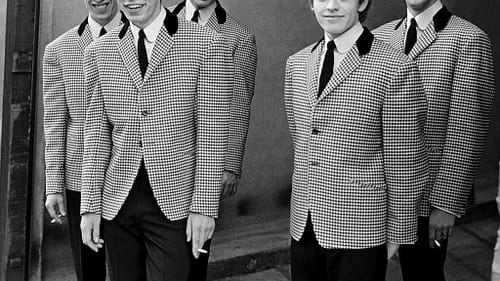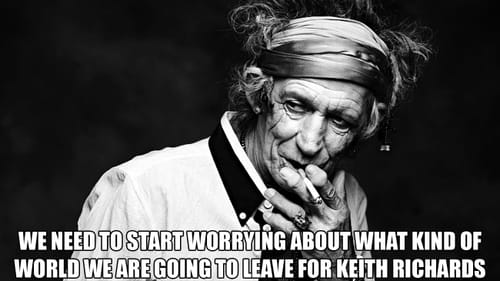Stay in the Loop
BSR publishes on a weekly schedule, with an email newsletter every Wednesday and Thursday morning. There’s no paywall, and subscribing is always free.
The importance of being Keef
Keith Richards: 'Life' and 'Under the Influence'

In 1964, the Beatles came to America with “I Want to Hold Your Hand.” A year later, the Rolling Stones exploded on the scene, yang to the Beatles’ yin, with “Satisfaction,” and the lines were drawn.
The Stones had no interest in being anyone’s lovable mop-tops — even when they were photographed in matching velvet-collared jackets, c. 1965, three of them were holding cigarettes. The differences from the Beatles were partly marketing, as guitarist Keith Richards admits in his 2010 autobiography, Life, but more importantly, they reflected the Stones’ deep, genuine commitment to American blues. When they were sidetracked into direct competition with the Beatles (viz. their brief foray into psychedelia, Their Satanic Majesties Request), they failed. When they did their own thing, though, they succeeded brilliantly — compare Beggars Banquet’s hard-line “Street Fighting Man” to the Beatles’ hippy-dippy “Revolution,” both from 1968.
The interplay between the Stones and the Beatles, however, wasn’t the only dynamic: There were also dissensions within each group. The Beatles broke up in 1970; though the Stones stayed together — for a full half century, as it turned out — creative and interpersonal tensions periodically erupted, most importantly between the two main songwriters and de facto bandleaders, Mick Jagger and Keith Richards.

Apollo and Dionysus
Mick is the Apollonian figure — despite his strutting, prancing stage presence, one never feels that Mick is in any danger of actually losing control — while Dionysian Keith is all about excess. Though Mick sang “Sympathy for the Devil,” Keith was perceived to be the true source of the band’s Mephistophelian power. His extremely heavy, and much publicized, drug use underlay his role writing and performing on four of the greatest rock and roll albums ever made: Beggars Banquet (1968), Let It Bleed (1969), Sticky Fingers (1971), and Exile on Main St. (1972). About half of Exile was recorded in the basement of Nellcôte, Keith’s French villa, during a period when he was taking heroin pretty much daily.
One rock great after another overdosed on heroin and other downers during this period, but despite being at the top of the “most likely to die” list for ten years straight, as he notes in Life, Keith avoided death through drugs, a couple of major fires, and other misadventures. His Faustian image grew, fed by stories — true, false, and somewhere in between (such as the “everyone knows” nugget that his heroin-suffused blood had been drained and replaced by fresh) — that emphasized both the fact and the unlikeliness of his survival.
In 1978, he finally got off heroin (though he didn’t embark on what a traditional 12-stepper would recognize as “recovery,” since he continued to use both alcohol and cocaine), and in 1979 he met model Patti Hansen, whom he married in 1983. The changes in his life reflected the changes in the lives of his core fans, the boomers, as they themselves settled down, albeit generally from a less depraved youth than Keith’s, and to a less glamorous middle age.

The devil, domesticated
Clean(ish) and married, he morphed from a satanic figure to a beloved one — his story didn’t change, per se; it just became recontextualized by his aging fans. Even his misadventures were tamed: His 21st-century brush with death came in 2006 when he fell out of a tree (not a palm tree, he says testily in Life, “just some gnarled low tree that was basically a horizontal branch”) in Fiji. A funny story, to be sure, but in fact a serious incident: He suffered a skull fracture that required surgery, and he finally, almost 30 years after getting off heroin, gave up cocaine in the wake of the accident.
Mostly, though, the contemporary take on Keith is that he’s, well, a scamp. Johnny Depp riffed on his persona in the Pirates of the Caribbean films, with Keith signaling he got the joke when he appeared as Jack Sparrow’s father in the third and fourth films in the series. Depp’s riff, however, was heavy on the eyeliner, light on the depravity.

Bill Nighy’s burnt-out rocker, Billy Mack, in Love Actually wasn’t just any burnt-out rocker — the characterization was rooted in a spot-on imitation of Keith’s speaking voice and laugh. Again, though, the movie character is toothless — Billy Mack flirts with the high life after a career resurrection, but returns at the end to the realest relationship in his life, his friendship with his manager, Joe (Gregor Fisher).
“An image like a ball and chain”
Obviously, the new Keith, like the old Keith, is a character, a persona, imposed on him from without — though not without his willing participation. The man began to consider his relationship to that persona by writing Life, which appeared in 2010. He wasn’t exactly stripping himself bare, though. For instance, he’s dismissive of the effect his drug use had on his children (Marlon, his son with Anita Pallenberg, was only seven when he toured with the Stones during the worst of Keith’s addiction).
One gets the sense that though the facts have been honestly reported in the book, the real meaning of the events so reported has not been examined, at least in print — as was his prerogative. His coauthor, James Fox, had been a friend since Fox first covered the Stones in 1973, providing a level of comfort for Keith that might have helped in some ways, but Fox may not have pushed him as hard on the darker passages of his life as a less intimate collaborator might have.
Life was not Keith’s final word on his life, though. He’s far more self-reflective in Under the Influence, the documentary recently released on Netflix. Perhaps the overwhelmingly positive reaction to the autobiography gave him the confidence to be more honest — perhaps the immediacy of the camera as audience caused Keith’s performer and/or daredevil side to kick in. In either case, he considers the way people perceive him more directly than he had in Life.
“It’s an image,” he says in the doc, “an image like a ball and chain. It’s not like a shadow, because it’s there 24/24 [sic]. When the sun goes down, it doesn’t disappear.”
His friend (and sometime collaborator) Tom Waits — a man with his own distinctive persona — goes a little deeper:
You have to have some type of armor so that you can continue to also develop as a human being. . . .It’s kind of a ventriloquist act. . .but it’s much safer than putting your ass out there, like Judy Garland, and melting every night.
So what’s behind the persona? Who’s the puppeteer in the ventriloquist act? Keith Richards is a man who loves music; a man who is a deeply knowledgeable and deeply talented musician; and a man who, God willing, may indeed outlive us all.
Sign up for our newsletter
All of the week's new articles, all in one place. Sign up for the free weekly BSR newsletters, and don't miss a conversation.
 Judy Weightman
Judy Weightman
 Illustration by Mike Jackson
Illustration by Mike Jackson